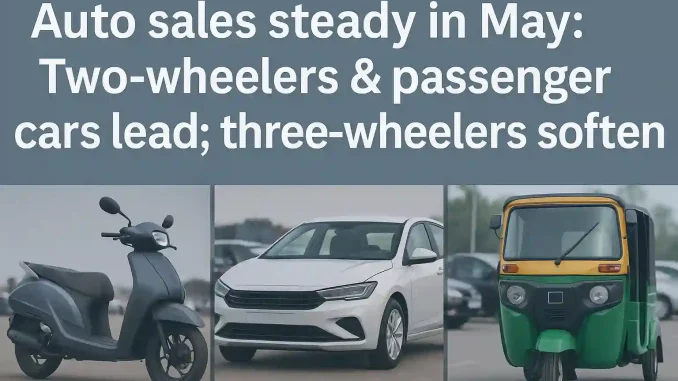
India’s automobile sector posted a largely steady performance in May 2025, as robust sales of two-wheelers and passenger cars helped offset a dip in the three-wheeler segment. According to data released by the Federation of Automobile Dealers Associations (FADA) and individual OEMs, industry-wide sales figures point to a cautious but consistent consumer sentiment in urban and semi-urban markets, even as certain categories show signs of saturation or policy-induced softness.
As the country gears up for the monsoon and the onset of the second fiscal quarter, May’s vehicle sales provide a crucial pulse check on post-pandemic recovery, demand shifts, and the readiness of Indian consumers to embrace both traditional and electric mobility options.
Key Numbers at a Glance (May 2025):
- Two-Wheelers: ~15.2 lakh units (↑11% YoY)
- Passenger Vehicles (PVs): ~3.6 lakh units (↑3.5% YoY)
- Three-Wheelers: ~48,000 units (↓5% YoY)
- Commercial Vehicles: ~83,000 units (flat YoY)
- Electric Vehicles (total across segments): ~1.12 lakh units (↑26% YoY)
Two-Wheelers Accelerate: Rural Rebound, Urban Style
India’s two-wheeler segment—long the backbone of personal mobility—continued its upward trajectory in May, clocking an impressive 11% year-on-year growth. With over 15 lakh units sold, demand was bolstered by rural market recovery, wedding season purchases, and new launches from key players like Hero MotoCorp, TVS Motor, and Bajaj Auto.
“Rural sentiment has improved thanks to pre-monsoon sowing optimism and government spending,” said an analyst from CRISIL. “At the same time, urban youth are showing renewed interest in premium scooters and bikes.”
Hero MotoCorp saw a 9.7% increase in sales, while TVS Motor posted an even stronger ~17% growth led by both ICE and electric variants. Electric two-wheeler manufacturers like Ather, Ola Electric, and Bajaj Chetak also reported significant upticks in urban centers.
Passenger Vehicles: Steady As She Goes
Passenger vehicle sales in May reached approximately 360,000 units, up 3.5% from the same period last year. Growth was largely driven by sport utility vehicles (SUVs) and compact cars, as Indian consumers continue to prioritize versatility and road presence over traditional sedans or hatchbacks.
Tata Motors, Hyundai, and Maruti Suzuki remained dominant players. While Tata’s EV sales continued to climb, Maruti led in the petrol segment, particularly with its Baleno, Swift, and the newly revamped Brezza.
“SUVs now account for nearly 55% of our total sales,” said a Maruti executive. “We’re seeing increasing demand for mid-size UVs that offer a mix of safety, space, and fuel economy.”
One standout was Mahindra, whose Scorpio-N and XUV700 continue to perform exceptionally well, backed by strong rural appeal and highway performance.
Three-Wheelers: A Surprise Soft Spot
In contrast to the momentum in two-wheelers and PVs, three-wheeler sales dipped by around 5% in May, attributed to multiple factors:
- End of FAME-II Subsidies: Uncertainty over electric three-wheeler subsidies following the phased withdrawal of FAME-II support impacted buying decisions.
- Financing Hiccups: Many small-scale buyers, particularly in tier-3 towns, continue to face difficulty securing favorable loans.
- Urban Saturation: Shared mobility models in cities may have hit temporary saturation, reducing fleet renewals.
Auto companies like Piaggio and Mahindra Last Mile Mobility are hopeful that upcoming state-specific subsidy announcements could help stabilize the segment in the coming months.
Commercial Vehicles Hold Ground
Commercial vehicle (CV) sales remained stable at around 83,000 units in May. The performance was propped up by steady demand for medium and heavy commercial vehicles (M&HCVs), particularly from the construction and logistics sectors.
Ashok Leyland and Tata Motors posted near-flat growth, citing a wait-and-watch approach from fleet operators. “While infra projects are progressing, retail CV buying remains slow,” a senior Tata Motors CV division official noted.
Light commercial vehicles (LCVs) showed muted growth, especially in rural corridors still recovering from high inflation and subdued consumption.
EV Sales: Quiet Surge Continues
Electric vehicles continued their steady upward march across segments. Over 1.12 lakh EVs were sold in May, led by electric two-wheelers and PVs.
Ola Electric posted record numbers, while Tata Motors’ Nexon EV and Punch EV maintained their lead in the electric car category. The EV market’s expansion was most prominent in urban clusters like Bengaluru, Delhi-NCR, Pune, and Hyderabad.
Charging infrastructure improvements and greater policy clarity in select states helped reduce consumer hesitancy, though supply-chain constraints—particularly the rare earth magnet shortage due to Chinese export curbs—may impact growth in the months ahead.
Retail vs. Wholesale: The Gap Narrows
For the past few quarters, OEMs have been adjusting their wholesale figures in response to unsold inventory build-up at dealerships. In May 2025, the gap between retail sales (actual customer registrations) and dispatch numbers narrowed, indicating improved alignment between supply and demand.
FADA President Manish Raj Singhania commented, “We are finally seeing rationalized inventory across categories. Dealerships are cautiously optimistic as we enter the monsoon period, traditionally a lean quarter.”
Looking Ahead: Monsoon, Policy, and Product Pipelines
The coming quarter will be influenced by three primary factors:
- Monsoon Progress: A good monsoon typically translates into strong rural demand for two-wheelers and LCVs. Early forecasts are optimistic.
- EV Subsidy Realignments: The replacement for FAME-II, expected to be rolled out under the “EV Acceleration Program (EAP),” could boost electric three-wheelers and commercial EV adoption if well-structured.
- Festive Pipeline: OEMs are preparing major launches for the pre-Diwali quarter. These include new SUVs from Kia and Toyota, electric scooters from Ola and Hero, and hybrid sedans from Maruti Suzuki-Toyota collaboration.
Leave a Reply